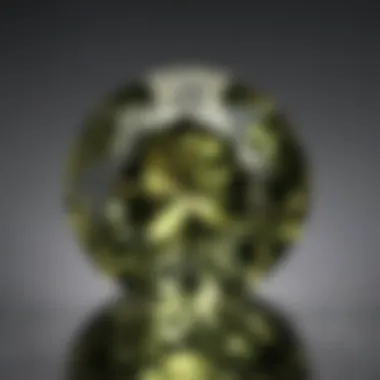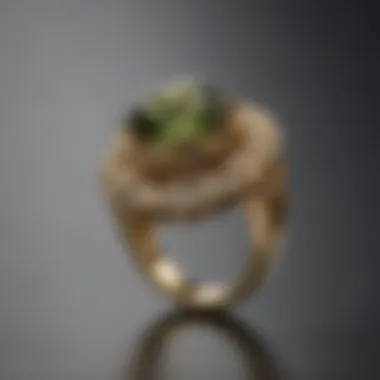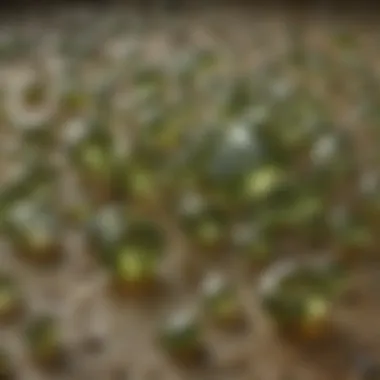The Allure of Olive Green Sapphire: A Gemstone Analysis


Intro
Olive green sapphire, often overshadowed by its blue counterpart, boasts a charm that intrigues gem enthusiasts and casual buyers alike. This richly hued gemstone offers more than just a distinct color; it carries a story of formation, significance, and beauty, making it a sought-after choice in the realm of jewelry. For those who wish to dip their toes into the world of sapphires, olive green deserves more than a passing glance. It is fascinating because its allure is steeped in both rarity and a unique presence within the spectrum of sapphires.
Overview of Gemstones and Minerals
The allure of gemstones often draws collectors and admirers from various walks of life, each captivated by the beauty and craftsmanship associated with these natural wonders. Gemstones, from sparkling diamonds to deep-blue sapphires, have held significance across cultures, often viewed as symbols of power, wealth, and spiritual connection.
History of Gemstone and Mineral Use
Historically, the use of gemstones can be traced back to ancient civilizations. Egyptians adorned themselves with lapis lazuli while Romans favored emeralds. In many cultures, these stones were not merely ornamental; they were believed to possess healing properties and served ritualistic purposes. The olive green sapphire, while not always in the limelight, fits into this rich tapestry, recognized through history in various forms.
Significance in Culture and Society
In contemporary society, gemstones symbolize personal milestones and achievements. Whether given as gifts or worn as fashion statements, gemstones often embody feelings and memories. The olive green sapphire, with its earthy tones, can symbolize harmony and balance, resonating with those who seek a deeper connection with nature or tranquility.
Gemstone Formation and Properties
To truly appreciate olive green sapphires, one must delve into their geological origins. The formation of these prized gems is a complex process, intertwining earth’s elemental forces.
Formation Process of Gemstones
Sapphires are formed under extreme heat and pressure deep within the Earth’s crust. The crystallization of corundum, the mineral family of sapphires, results in a variety of colors depending on the presence of trace elements. For olive green sapphires, iron plays a critical role, imparting that unique hue.
Properties that Define Gemstones
Several defining properties characterize sapphires:
- Hardness: Sapphires score a 9 on the Mohs scale, making them remarkably durable.
- Luster: They typically possess a vitreous luster, causing them to shine brilliantly in the light.
- Clarity: Transparency can vary; however, high-quality sapphires exhibit minimal inclusions.
Classification based on Color, Hardness, and Luster
While most people associate sapphires with blue, the variety of colors includes yellow, pink, and, of course, olive green. Each hue signifies its own unique story from geological perspective to personal preference.
Types of Gemstones
The gemstone world is broad, with categories that can sometimes blur the lines.
Precious vs. Semi-Precious Gemstones
Typically, gemstones are classified as precious or semi-precious. Traditional precious stones include diamonds, rubies, emeralds, and sapphires. Olivine, as a variety of quartz, falls into the semi-precious category, yet its quality can rival that of its more illustrious counterparts.
Common Gemstone Varieties
Popular varieties such as amethyst, garnet, and citrine often capture the attention of buyers, while unique colors like olive green in sapphires highlight the diverse palette available in gemstone selections.
Exotic and Rare Gemstones
Exotic gemstones consistently pique interest due to their uniqueness and beauty. Olive green sapphires, while not among the most commonly known, stand out for their rarity and distinct hue, making them a fascinating addition to collections.
Identifying and Evaluating Gemstones
Identifying the right gemstone often requires a keen eye and knowledge of key factors affecting value and quality.
Factors Affecting Gemstone Value
When evaluating olive green sapphires, crucial considerations include:
- Color: Depth and vividness of olive green impact desirability.
- Clarity: The fewer the inclusions, the higher the value.
- Cut: Quality and precision of the cut weigh significantly in evaluation.
Techniques for Gemstone Identification


Identifying true gemstones can involve using tools such as:
- Refractometers: To measure how light bends when entering the stone, offering clues about its identity.
- Loupe: A jeweler’s loupe magnifies the gemstone to check for inclusions and surface condition.
Assessing Gemstone Quality
A quality assessment of olive green sapphires can be made by observing the traits mentioned above alongside expert appraisals, ensuring an informed purchase.
Caring for Gemstones
Even the most exquisite gemstones require proper care to last a lifetime.
Cleaning and Storing Gemstones Properly
To maintain the luster of olive green sapphires, they should be cleaned with a soft cloth and mild soap. Storing them away from other jewelry prevents scratches and damage.
Avoiding Common Mistakes in Gemstone Care
Some common pitfalls include exposing gemstones to harsh chemicals or extreme temperature changes. Awareness of these pitfalls can aid in preserving the beauty of the stone long-term.
Preservation Tips for Specific Gem Types
Olive green sapphires, while more durable than some gemstones, should still be treated delicately. Regular checks for loose settings or damage help ensure they remain as stunning as when first purchased.
"Caring for your gemstones is as essential as selecting the right one; it preserves the heirlooms of the future."
In summary, olive green sapphires are not only a treat for the eyes but are steeped in geological history and cultural significance. An exploration into their world reveals the complexities and beauty of these distinctive gemstones, allowing for a deeper appreciation among enthusiasts and collectors.
Preamble to Olive Green Sapphire
In the realm of precious gemstones, olive green sapphires often take a back seat to their more famous counterparts like blue or pink sapphires. However, the allure of this specific gemstone should not be underestimated. Understanding olive green sapphire is crucial for anyone with a passion for gemstones, as it comprises not only a rich history but also distinct characteristics that set it apart.
The olive green color, reminiscent of a lush forest or verdant hills, offers a unique aesthetic that resonates with many. For jewelers and collectors alike, this coloration adds an earthy quality to the common sapphire, making it appealing to those who prefer subtler elegance. Furthermore, these sapphires can reflect a range of tones, from warm olive hues to lighter shades, making each stone unique.
One of the major advantages of olive green sapphire lies in its versatility. It pairs beautifully with various metals and styles, seamlessly transitioning from casual wear to more formal settings. This adaptability not only broadens its market appeal but also enhances its desirability for custom jewelry designs.
Another point worth noting is the rarity of olive green sapphires. While sapphires in other colors are more commonly found, the olive green variety tends to be rarer. This scarcity contributes to its growing popularity in the market, particularly among collectors looking for something distinctive.
As we further explore this fascinating gemstone throughout the article, we will cover its geological formation, characteristics, significance in jewelry design, and care recommendations. Each aspect plays a critical role in enhancing our understanding of olive green sapphires and underscores why they deserve a spotlight in the gemstone world.
"Olive green sapphires encapsulate nature's beauty in a gem, providing a refreshing twist in the vibrant world of gemstones."
In summary, equipping oneself with knowledge about olive green sapphires is vital for anyone looking to deepen their appreciation, whether as a collector or designer. Delving further into the details will illuminate the various facets that make this gemstone a treasure in its own right.
The Geological Formation of Sapphires
Understanding the geological formation of sapphires is pivotal for anyone fascinated by this exquisite gemstone. Sapphires, with their alluring colors and remarkable properties, are not merely a product of nature's whim; they're the result of complex geological processes that unfold over eons. This section unpacks the formation of sapphires, shedding light on the specific conditions that contribute to their unique characteristics and, ultimately, their value in the market.
Understanding Gemstone Origins
Sapphires originate from a mineral called corundum, primarily composed of aluminum oxide. The fascinating thing about gem quality sapphires is that their uniqueness stems largely from the trace elements embedded within their structure. For instance, the presence of iron and titanium can infuse a sapphire with that sought-after blue hue, while chromium might turn it a vibrant red, transforming it into a ruby. Olive green sapphires, in particular, owe their rich color to different combinations of iron and other elements in specific geological environments. This makes their genesis not just a chemical reaction but a splendid interplay of minerals, heat, and time.
"The color of sapphires is affected by the specific makeup of minerals present during their formation, making each stone uniquely beautiful and rare."
When considering the origins of sapphires, it’s worth noting that they can be found in various locations around the globe, each conferring distinct personality traits to its stones. While some regions yield vibrant blue sapphires, others produce the enticing olive green variants, indicating a rich tapestry of geological diversity fed by various environmental factors such as soil composition and tectonic activity.
The Role of Heat and Pressure
Heat and pressure are at the heart of sapphire formation. Sapphires form deep within the Earth's crust, under conditions that not only apply significant pressure but also bring about high temperatures. Over millions of years, these conditions can transform simple minerals into beautiful gemstones.
For the olive green sapphire, these high-pressure environments, coupled with elevated temperatures, help transition aluminum oxide into its crystalline form while allowing trace elements like iron and chromium to mix in harmoniously, thus shaping the stone's final color and clarity.
Interestingly, the heat doesn't only serve to form the stone; it can also affect its clarity. For example, a stone that is subjected to rapid cooling might develop internal characteristics, which could either enhance or diminish its overall value. This connection between environmental factors and the finished gem is what makes studying geological formations so captivating.


Rarity in Geological Context
Nailing down the rarity of olive green sapphires involves looking at their formation in context with geographical and environmental conditions. Unlike the more common blue sapphires, olive green sapphires emerge from specific, sometimes isolated locations, leading to fewer instances of their discovery.
- Geological Scarcity: Many gems become scarce due to limited geological conditions. Olive green sapphires tend to form in regions where the right balance of minerals and heat exists, making them less prevalent than other varieties.
- Environmental Influences: Factors like climate and tectonic movement can influence the availability of sapphires. In places where mining practices are restricted, or the geological conditions change, these gems can truly become rare treasures.
- Market Demand: The rarity also drives interest. As more collectors and enthusiasts seek out olive green sapphires for their unique hue and charm, this increases their desirability and can affect market value significantly.
In summary, the geological formation of sapphires is nothing short of a complex narrative that unfolds over millions of years. Understanding this fascinating journey not only adds depth to one’s appreciation of olive green sapphires but also highlights the reasons behind their unique allure and market value.
Characteristics of Olive Green Sapphires
Understanding the characteristics of olive green sapphires is vital in grasping their unique appeal. This section provides insights into important aspects such as color definition, clarity, transparency, and cut quality—all elements that directly influence their desirability and value in the market.
Defining Color in Sapphires
The color of a sapphire, particularly olive green, can be seen as its most defining trait. Unlike traditional blue sapphires which often dominate the market, olive green sapphires present a refreshing departure from the norm. Their color ranges from a light lime to a deeper, richer green, sometimes infused with yellow or brown tones. This jade-like hue has a charm that can captivate the eye and evoke a sense of nature's serenity.
When it comes to color grading in gems, several factors come into play: hue, tone, and saturation. The hue refers to the dominant color seen in the gemstone. In the case of olive green sapphires, green is the principal hue, but hints of yellow may also appear. Tone indicates the lightness or darkness of that green, and saturation measures the intensity or vividness of the color. An olive green sapphire that strikes a perfect balance between these elements—more saturated, yet not too dark—tends to fetch a higher price. As a result, understanding these nuances is key for enthusiasts and collectors alike in assessing the beauty and market appeal of these stones.
Clarity and Transparency
When evaluating olive green sapphires, clarity is another significant characteristic. Clarity describes the presence or absence of internal inclusions or flaws. The clearer the stone, the more desirable it is, generally speaking. However, some may appreciate the unique inclusions that offer a sapphire its individuality: much like a fingerprint, no two stones are alike, and those quirks can tell an intriguing story about the stone’s journey.
The transparency of the sapphire also plays a crucial role in its allure. A highly transparent olive green sapphire allows light to bounce in and out, creating brilliant reflections that draw the eye. Gems that appear murky or cloudy can diminish the visual impact, and thus their market value often takes a hit. Therefore, when searching for the perfect olive green sapphire, one must carefully inspect both its clarity and overall transparency.
Cut and Quality Assessment
The cut of a sapphire is not merely about its shape; it encompasses the overall craftsmanship—how well the facets are designed to enhance the stone's natural properties. An expertly cut olive green sapphire maximizes its brilliance and scintillation, allowing it to sparkle under light. There are various cuts, including round, cushion, emerald, and oval shapes, each lending a different character to the stone.
Quality assessment takes into account the proportions of the cut. A well-proportioned sapphire should appear symmetrical, maintaining uniformity around its axis. A poorly cut stone may appear lifeless, lacking that coveted sparkle. Also, the setting of the sapphire in jewelry plays a critical part in how it is perceived. Jewelers must consider how the cut complements the overall design to enhance the stone’s inherent beauty.
For gem enthusiasts and designers, paying attention to these characteristics is paramount. They not only determine the aesthetic value of a sapphire but also influence its rarity and market demand, making them critical factors when investing in olive green sapphires. With all these unique traits, it's clear why these gemstones hold such fascination.
The Significance of Color in Olive Green Sapphire
Color is undoubtedly the heart and soul of a sapphire, particularly the olive green variety. When we consider gemstones, many fans often gravitate towards the well-known vibrant blue sapphires. Yet, the allure of olive green sapphires deserves just as much attention. This unique hue tells a story of its own, enriched by geological and cultural significance. In this section, we will explore how color not only defines the aesthetics of this gem but also affects its market value and desirability.
The Color Spectrum of Sapphires
Sapphires are prized for their wide range of colors, from fiery red to serene blue and even the understated shades of green and yellow. The world of sapphires operates under a spectrum, where olive green sits comfortably between vibrant green and deeper hues of brown. The blend of yellow and blue trace elements primarily contributes to the olive tone.
To better understand this color spectrum, one might consider the following elements that influence the coloration:
- Trace Elements: Iron and titanium are often the culprits. In the case of olive green, these elements stir the pot, creating that rich yet subtle tone.
- Lighting Conditions: Interestingly, the appearance of olive green can shift based on the light. In daylight, the green can pop vibrantly. Under artificial light, it might appear more muted.
- Color Zoning: Many sapphires exhibit color zoning—segments of distinct colors in the same stone. This factor can add depth to the gemstone and create a unique visual charm.
When considering purchasing an olive green sapphire, understanding its color can serve as a vital tool for both appreciate and investment.
Olive Green vs. Other Sapphire Colors
When lined up side by side, olive green sapphires bring a refreshing contrast to their more commonly known counterparts. Comparing olive green sapphires to other colors reveals some fascinating distinctions:
- Aesthetic Appeal: Olive green's earthy tones offer a more understated elegance. In comparison, blue sapphires might represent royalty and luxury, while yellow sapphires exude warmth. Those who appreciate subtlety often find themselves drawn to olive green.
- Versatility: The muted color palette of olive green allows it to complement a wide range of other gemstones, metals, and designs. A piece featuring olive green can easily be worn in casual settings or formal occasions, making it a practical choice for jewelry designers.
- Market Value: While blue sapphires dominate the market, olive green sapphires tend to attract discerning collectors who seek something distinct. The rarity of high-quality olive green sapphires can contribute to their value, often placing them well above common color varieties.
Applications of Olive Green Sapphire in Jewelry Design
Olive green sapphire leaves a remarkable impression in the realm of jewelry design. As the stones are versatile, they fit beautifully into various styles, from classic to contemporary. Their unique hue often features a combination of a rich green and warm yellow that can blend seamlessly with different metals and designs. The application of olive green sapphire in jewelry is not merely about aesthetics; it encompasses emotional connections, lifestyle choices, and broader trends within the jewelry market. This section will dive into how olive green stones are changing the game in jewelry design and why so many are drawn to their charm.
Setting Trends in Contemporary Jewelry
In recent years, olive green sapphire has made waves in the jewelry scene. Designers are experimenting with the color, using it in unconventional ways to communicate freshness and individuality. You will find this striking gemstone in bespoke pieces, often paired with white diamonds or set in yellow gold. This pairing enhances the earthy quality of olive green sapphires while giving the jewelry a delicate yet bold appeal.
"Olive green sapphires are like a breath of fresh air in a jewelry box filled with traditional gems; they just pop!"
With environmental concerns at the forefront, many consumers are searching for ethically sourced materials. Designers utilizing olive green sapphires tap into this trend, resulting in jewelry that appeals not only on a visual level but also resonates ethically. The hue perfectly symbolizes a natural aesthetic, appealing to those who appreciate rustic beauty in their adornments.


Choosing Designs for Olive Green Sapphires
Selecting the right design for olive green sapphires often calls for consideration of several aspects: the metal choice, settings, and complimentary gems. Each piece can tell a story that resonates deeply with the wearer.
- Metals such as gold or rose gold can amplify the warmth of the sapphire's color and give a cozy feel.
- Minimalist settings, such as bezel or prong, allow the stone to be the star of the show, spotlighting its unique hue.
- Interestingly, combining these with other gemstones can create intriguing contrasts. For instance, pairing olive green sapphires with rich blue sapphires or clear diamonds showcases both stones brilliantly.
Moreover, considering the wearability for various occasions is crucial. Designs that combine elegance with comfort often attract a wider audience. Casual yet exquisite everyday wear, such as stud earrings, contrasts sharply with extravagant statement necklaces, which shine at formal events. This flexibility allows olive green sapphire to become a staple in anyone's jewelry collection.
In summary, the innovations in using olive green sapphires in jewelry design not only underscore the beauty of the stones but also reflect prevailing cultural currents and consumer desires. As trends evolve, the role of these sapphires in jewelry will likely expand, drawing in both seasoned collectors and new enthusiasts alike.
Caring for Olive Green Sapphires
Caring for olive green sapphires is crucial not just for maintaining their aesthetic appeal, but also for preserving their inherent value over time. For gemstone enthusiasts and collectors, understanding the nuances of sapphire care can mean the difference between a dazzling accessory and a dull disappointment. These unique gems are often set in fine jewelry, making proper maintenance paramount; after all, a sapphire that sparkles like a finely tuned instrument enhances both personal style and investment potential.
Routine Maintenance Techniques
The beauty of olive green sapphires lies in their depth and hue, which deserve regular attention to keep them looking brand new. Here are some practical maintenance techniques:
- Regular Cleaning: Use a soft, lint-free cloth to wipe the stone after wearing it. This simple step can prevent the buildup of oils and dirt that cloud the stone's natural brilliance.
- Soak in Mild Soap: Periodically, it helps to soak the sapphire in a solution of warm water mixed with a few drops of mild dish soap. Letting it sit for about 15-20 minutes allows dirt to loosen. Gently brush with a soft brush, like an old toothbrush, to get into any crevices.
- Avoid Harsh Chemicals: Cleaning products containing strong chemicals can be detrimental. Avoid acetone or ammonia, which may cause irreversible damage to the stone.
- Professional Cleaning: Every now and then, it could be worth it to have the sapphire professionally cleaned. Jewelers have specialized equipment and knowledge to maintain sapphires, giving them that extra polish that home techniques might miss.
Adopting these strategies not only keeps your olive green sapphire shining bright but also safeguards its long-term integrity. They appreciate time and indulgence, similar to any treasured possession that holds a significant place in one’s heart.
Storage Recommendations
Storing olive green sapphires correctly can prevent scratches and damage, ensuring they remain a captivating sight. Here’s how to store these gems optimally:
- Individual Soft Pouches: Each sapphire should be kept in its own soft cloth pouch, preventing direct contact with other gemstones which may scratch the surface.
- Avoid Extreme Conditions: Store the stones in a temperate environment, away from direct sunlight. Extreme heat or cold can adversely affect the sapphire.
- Use a Jewelry Box with Dividers: A jewelry box equipped with dividers can help neatly lay out each piece, reducing the chances of scratching and entangling.
- Check Frequently: Make it a habit to check your stored sapphires periodically. Look for any changes in color or clarity, which might indicate that something’s amiss.
Remember, caring for your olive green sapphire is akin to nurturing a cherished relationship; it requires time, sensitivity, and an understanding of its unique demands. This care practice not only enhances the appearance of the gemstone but also secures its value in the ever-evolving market.
Even the most beautiful gem can lose its luster without proper care.
The commitment to preserve these exquisite sapphires reflects not just appreciation for beauty, but a wise investment in longevity.
Market Value and Rarity of Olive Green Sapphire
Understanding the market value and rarity of olive green sapphires adds another layer of appreciation for this distinct gemstone. While many sapphires flaunt deeper hues of blue or vivid pinks, olive green sapphires carve out their niche with a subtle elegance that often goes unnoticed. This section sheds light on the factors affecting their price and scarcity, aiming to give gemstone aficionados a clearer picture of what makes this stone special.
Factors Influencing Market Prices
The market price of olive green sapphires can fluctuate based on several critical elements. To grasp the nuances of this pricing, consider the following:
- Color Hue: Not all olive greens are created equal. The shade can vary from yellowish-green to a deep olive; the more vivid and well-saturated the color, the higher the price tends to be.
- Clarity: Sapphires are usually valued by their clarity. Those that are visibly flawless command a premium. Inclusion factors—tiny imperfections within the stone—can significantly lower a sapphire's market worth.
- Size and Weight: Larger stones often fetch higher prices, particularly if they maintain quality in color and clarity. The carat weight is a standard metric for valuation.
- Cut Quality: The craftsmanship involved in cutting the sapphire can cause pricing discrepancies. A well-formed cut that maximizes the stone’s sparkle can increase its market value.
- Origin: The source of the sapphire can impact its desirability and price. Certain regions are known for producing gem-quality stones, making those sapphires more sought-after. For example, a sapphire from Sri Lanka may hold a different value compared to one sourced from Australia due to varying mineral compositions in the regions.
These factors play a crucial role in determining how olive green sapphires are positioned in the market. As a collector or enthusiast, being mindful of these influences can help in discerning the true worth of a stone.
Evaluating Investment Potential
When contemplating the investment potential of olive green sapphires, several considerations come to the fore:
- Historical Trends: Analyzing previous market trends for similar gemstones can provide insights into potential appreciation in value. Historically, rare and unique gemstones have seen price fluctuations driven by collector demand.
- Rarity: Olive green sapphires are not as commonly found as their blue counterparts, adding an element of rarity to their market stature. This scarcity can lead to increased value, especially if buyers begin to seek them for unique jewelry pieces.
- Market Demand: Keeping an ear to the ground on jewelry trends and collector preferences can help gauge future interest. With an ever-changing fashion landscape, the charm of olive green sapphires could soon become the next big thing.
- Quality Assurance: Purchasing from reputable dealers or gemologists who provide certifications improves the likelihood of a wise investment. These certifications can assure buyers of the gemstone's authenticity and quality, protecting against future depreciation.
Culmination and Future Prospects
As we wrap up our exploration of olive green sapphires, it's crucial to reflect on their significance not just as gemstones, but as symbols that encapsulate deeper values and aesthetics. This section draws attention to the continuing charm that olive green sapphires hold within the gemstone world and anticipates future trajectories for their popularity.
The Lasting Appeal of Olive Green Sapphire
Olive green sapphires have a unique place in the gem industry. Their rich, earthy tone often evokes feelings of nature, resilience, and originality. Unlike the more widely recognized blue sapphires, olive green variants offer a refreshing twist. Collectors and enthusiasts are increasingly drawn to them for their subtle sophistication and rarity. As trends in personalized and unique jewelry grow, the allure of olive green sapphires becomes even more pronounced. This gem's versatility allows it to be stunning in both vintage and modern settings, appealing to a broad range of tastes.
Moreover, the high clarity and intriguing shades of the stone make it suitable for a variety of designs. From rings to necklaces, these gems shine brilliantly, enhancing the overall aesthetic of any piece. As people move away from clichéd trends and seek more representative options, olive green sapphires stand poised to capture collectors' and designers' imaginations alike.
"In a world filled with choices, the rarity of olive green sapphires speaks volumes about individuality and personal expression."
Predictions for Upcoming Trends
Looking ahead, several factors suggest that the demand for olive green sapphires may increase significantly. Awareness and education about gemstones are on the rise, with information readily available. As more people understand the unique characteristics of olive green sapphires, interest is expected to flourish.
- Sustainability Movement: As consumers become more eco-conscious, ethically sourced and sustainable materials are rising. Olive green sapphires, often mined with less environmental distress, may attract environmentally aware buyers.
- Custom Jewelry Designs: There’s a palpable shift towards personalized jewelry. With their distinctive color, olive green sapphires can be the centerpiece in custom designs, resonating with individual preferences.
- Digital Engagement: The continuous evolution of technology enables better access to purchasing gems online. As virtual showcases become more commonplace, the exposure of olive green sapphires can increase, reaching a broader audience.
- Influenced by Trendsetters: Celebrities and influencers are often seen as trendsetters. If they choose olive green sapphires for special occasions, the demand may spike, attracting a younger demographic who want to emulate these styles.







